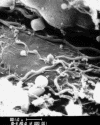The emergence of Lyme disease
- PMID: 15085185
- PMCID: PMC385417
- DOI: 10.1172/JCI21681
The emergence of Lyme disease
Abstract
Since its identification nearly 30 years ago, Lyme disease has continued to spread, and there have been increasing numbers of cases in the northeastern and north central US. The Lyme disease agent, Borrelia burgdorferi, causes infection by migration through tissues, adhesion to host cells, and evasion of immune clearance. Both innate and adaptive immune responses, especially macrophage- and antibody-mediated killing, are required for optimal control of the infection and spirochetal eradication. Ecological conditions favorable to the disease, and the challenge of prevention, predict that Lyme disease will be a continuing public health concern.
Figures





References
-
- Steere AC. Lyme disease. N. Engl. J. Med. 2001;345:115–125. - PubMed
-
- Dennis, D.T., and Hayes, E.B. 2002. Epidemiology of Lyme Borreliosis. In Lyme borreliosis: biology, epidemiology and control. O. Kahl, J.S. Gray, R.S. Lane, and G. Stanek, editors. CABI Publishing. Oxford, United Kingdom. 251–280.
-
- Lyme disease: United States, 2000. Morb. Mortal. Wkly. Rep. 2002;51:29–31. - PubMed
-
- Steere AC. Lyme disease. N. Engl. J. Med. 1989;321:586–596. - PubMed
-
- Spielman A. The emergence of Lyme disease and human babesiosis in a changing environment. Ann. N. Y. Acad. Sci. 1994;740:146–156. - PubMed
Publication types
MeSH terms
Grants and funding
LinkOut - more resources
Full Text Sources
Other Literature Sources
Medical

